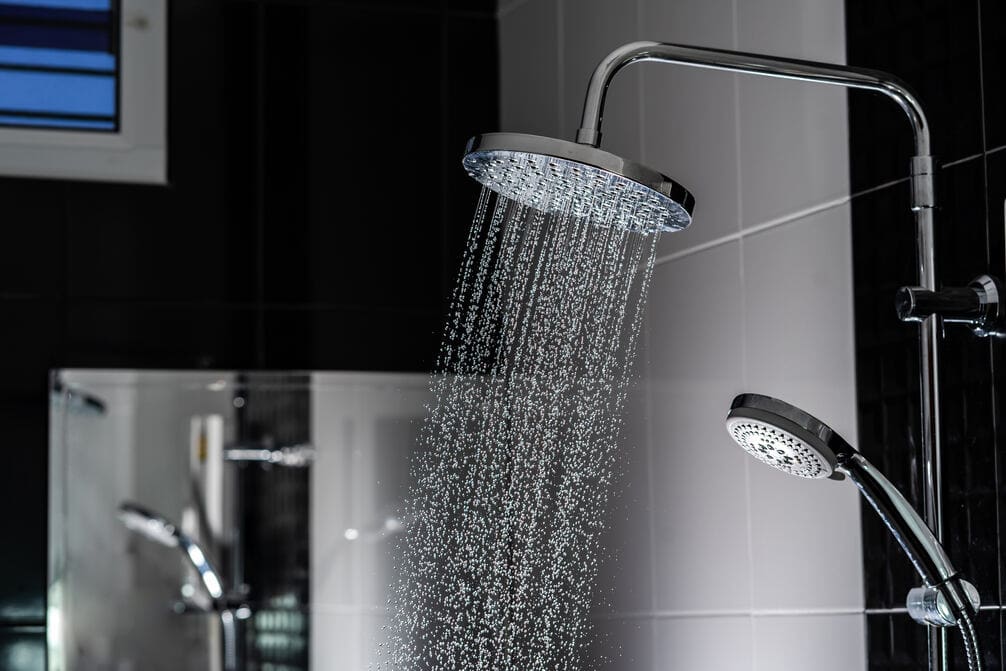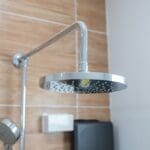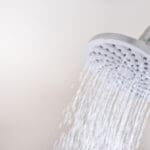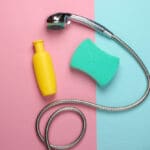While a loose shower head might seem like a minor nuisance at first, it can quickly escalate into a major inconvenience, disrupting your daily routine. You’re in luck because fixing this issue doesn’t have to be a daunting task.
By donning a pair of rubber gloves for protection and using JB Weld Water Weld epoxy putty, you’re already halfway there. This simple, yet effective, method involves mixing the putty until it achieves a uniform white color, then shaping and applying it to secure the shower arm firmly in place.
But the real secret to ensuring a long-lasting solution lies in the details of the application and drying process, which we’ll explore further. By following these steps, you’ll not only save money but also extend the life of your shower head, ensuring it remains stable and functional for years to come.
Key Takeaways
- Identifying the problem accurately is crucial for fixing a loose shower head.
- Using essential tools like rubber gloves and epoxy putty simplifies the repair process.
- Patience is important during the drying process of the epoxy putty.
- A secure shower head enhances the overall shower experience and saves money on professional repairs.
Identify the Problem
To effectively address the issue, first ascertain whether the wobbling is isolated to the showerhead by checking for side-to-side movement. This initial step is crucial to identify the problem accurately. Gently grasp the showerhead and gently move it side to side. If you notice a significant amount of play, this indicates that the shower arm, rather than any other part, is the culprit behind the instability. It’s essential to understand that a certain cavity within the showerhead design allows for some movement, but excessive wobbling signifies a need for attention.
Focusing on the shower arm is key to resolving the issue at hand. Since the movement is only present in the showerhead and not in other parts, this narrows down the potential problems, making it easier for you to tackle the repair. The main goal is to stabilize the shower arm to prevent further wobbling and ensure a steady water flow. By pinpointing the issue to the shower arm, you’re taking the first and most critical step towards a successful repair.
Identifying the problem accurately sets the stage for the next steps in fixing your loose shower head effectively.
Gather Your Tools
Before you tackle the issue of a loose shower head, you’ll need to gather a couple of essential tools: rubber gloves and JB Weld Water Weld epoxy putty. These items are crucial for a smooth repair process, ensuring you’re gonna stick it right back where it belongs without a hitch.
When you gather your tools, remember simplicity is key. You won’t need an entire toolbox; the solution is straightforward and cost-effective. Here’s what you should have at hand:
- Rubber gloves: These will protect your hands from the epoxy putty and any grime you might encounter during the repair.
- JB Weld Water Weld epoxy putty: Selected for its ease of use and strong bond, this putty is your go-to material for fixing the shower head.
- Clean cloth: Though not mentioned earlier, a clean cloth is handy for wiping off any excess putty or moisture before applying the epoxy.
- A bit of patience: A simple tool, yet essential. Allow the epoxy time to cure for the best results.
Having the right tools won’t only make the repair process easier but also ensure a durable fix. So, gather your tools and get ready to restore your shower head to its proper position.
Secure and Test
Carefully pack the epoxy putty into the showerhead’s cavity, ensuring it’s secure from both sides for maximum stability. This step is crucial; you’re going to take your time to make sure the putty is evenly distributed, providing a solid foundation for the shower arm. The goal here is to create a bond that’s not just strong but lasting.
After applying the putty, it’s essential to let it dry completely. This isn’t the time to rush. The drying process is what’s going to solidify your repair, making the showerhead as stable as it was the day it was installed. I’ll show you how patience pays off in this step.
Now, for the moment of truth: testing. Once the putty has hardened, give the showerhead a gentle but firm tug. You’re looking for zero movement here. Apply some pressure, simulate the motions it’ll go through during a typical day. If there’s no give, congratulations, you’ve successfully secured your showerhead.
If the showerhead remains immovable and feels stable, your efforts have paid off. You’ve not only fixed the issue but also ensured a safer, more reliable shower experience.
Frequently Asked Questions
How Do You Fix a Wobbly Shower Head?
To fix a wobbly shower head, first identify if the shower arm’s loose. Use rubber gloves to mix and apply JB Weld Water Weld epoxy putty into and around the cavity, then let it dry completely.
What Can I Use to Tighten My Shower Head?
To tighten your shower head, you’ll need rubber gloves and JB Weld Water Weld epoxy putty. Mix the putty until white, then shape and pack it into the shower head’s hole for a solid fix.
How Do You Tighten a Sliding Shower Head?
To tighten a sliding shower head, you’ll first need to identify the mechanism causing the slide. Often, a simple adjustment of the collar or tightening screws at the base can secure it back in place.
How Do You Fix a Loose Hand Held Shower Head?
To fix a loose handheld shower head, first inspect the connection. If it’s the hose, tighten it by hand. If the issue persists, replace the washer inside the hose connector for a secure fit.





